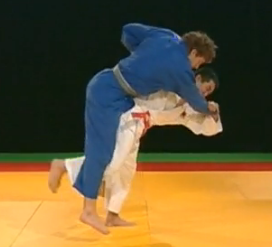Regular readers of the Fundamentals series may have noted that I have covered topics in a tiered manner. Giving you tools which you can use and apply to develop your Judo. This is a continuation within that greater scheme, as it is critical to have read earlier threads to gain anything meaningful from this one. So if you haven’t read these threads take the time to familiarise yourself with the material contained within first, then return to this thread;
Continual Kuzushi
Attacking the Chest
In response to many questions about Judo I have consistently used one word ‘control’.
The ‘control’ that I use is a bit of a broad brush term as we use it to refer to a variety of things from control during a throw, to control over space, control over uke etc... Here I am focusing on control during the process of throwing.
Shimekomu is a term that many of you will probably not have heard and indeed I have still to hear it used on a Judo mat. I first read it on Judoforum in a post by Ptnippon and even though I had never heard it or really been specifically taught it. I realised that it was a key part of what my coaches were teaching and what I was trying to develop. Often with these things it takes an awareness of something to help us focus on it and realise its relevance, such was the case for me, with shimekomu.
Shimekomu means roughly translated ‘to lock up’. It is a core element in a successful throw and starts as kuzushi begins to turn to tsukuri and continues well into kake and facilitates dodome. Shimekomi is facilitated by proper tsurikomi and kuzushi and proper tsukuri they work together to be mutually reinforcing in producing the shimekomi.
Shimekomi results when through correct application of kuzushi and correct tsukuri uke’s is ‘locked’ in a position where they are unable to correct their posture, regain their balance or fight off the throw attempt. I’m by no means particularly good at Judo, that needs to be emphasised because this is a bit of a brag. A few times now I have had people describe my O soto gari and O uchi gari as ‘sticky’ or words to that effect. In that once I had entered for the throw even if I didn’t throw them in a perfect demo fashion they felt unable to move or get off the technique. This is them experiencing shimekomi.
You should already be laying the foundations for your throws to have shimekomi by developing good tsurkiomi and kuzushi actions and good tsukuri through uchikomi – static and dynamic. However, learning how to apply shimekomi is a skill that needs to be developed in and of itself. To develop it requires a specific type of uchikomi.
Here is uchikomi as it is usually practiced to develop kuzushi and tsukuri
There is nothing wrong with this kind of Uchikomi!
However, it doesn’t specifically train shimekomi. To train shimekomi through uchikomi requires a fuller entry moving further through the tsukuri phase and close to kake.
I was unable to find a good example of shimekomi training in a static situation. However this conveys the general idea even though it’s a different drill:
Moving uchikomi to train dynamic shimekomi
As you will have observed the key common feature is the loading of uke by tori. Now loading in of itself isn’t the principle aim otherwise it would be impossible to practice Tai otoshi or O uchi gari in developing shimekomi. However, it’s helpful in illustrating the principle in that tori has complete control over uke’s fate and uke has no real chance of escaping the throw if it was at full speed and done to completion.
For an Uchi mata shimekomi orientated uchikomi would be to take the throw to this phase and then return uke to their feet do a full exit and then full entry to this point again.
For throws like Tai Otoshi and O soto gari shimekomi uchikomi requires experience a good uke and communication between uke and tori. So that uke can help tori achieve and help them know when they’ve managed to give their throw shimekomi.
Utilising uchikomi to develop shimekomi in your throwing techniques is vital. It positively feeds into your nagekomi and randori. Many beginners and even those at high level struggle with the problem of throw slippage where they lack control throughout the throwing action to effectively throw and control the landing of their partner to ensure ippon or a successful transition into newaza.
It is also useful in helping people to bridge the conceptual and technical gap between static uchikomi and randori. Many people often question the approach of uchikomi pointing to the disconnect between it and randori or how a throw is applied in randori. However, unless you develop the key skills of control –tsurikomi, continual kuzushi, shimekomi etc... you will never be able to properly apply a throw in either nagekomi or randori.
I hope this has been useful and informative. As ever comments, critiques and thoughts are welcome.


Great stuff! Lots to think about, thank you for taking the time to write it.
ReplyDeleteThank you. Glad you found the post helpful.
ReplyDeleteMy instructor showed us the drill from the last video with o goshi and ippon seoi nage before our yellow belt grading. He never mentioned shimekomi, but made us go through the throws slowly, stopping with uke "flying" on toris back without actually dropping uke. Before that drill lots of us noobs rushed through the throws without any control over uke, i think it's great for making sure you aren't just muscling through the throw
ReplyDelete